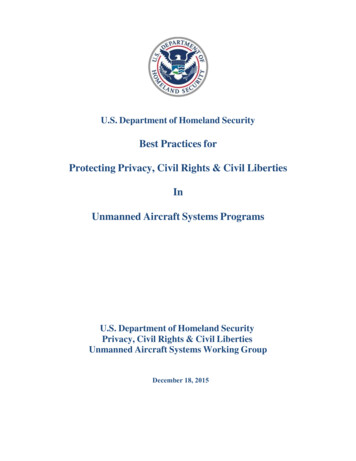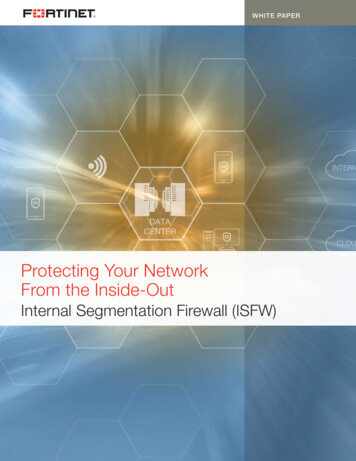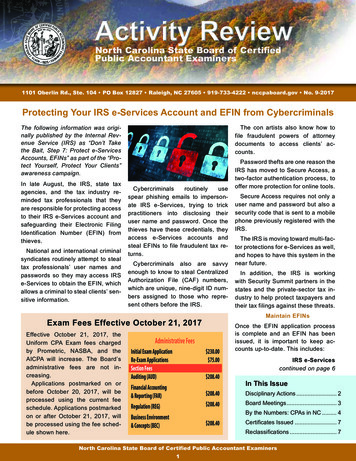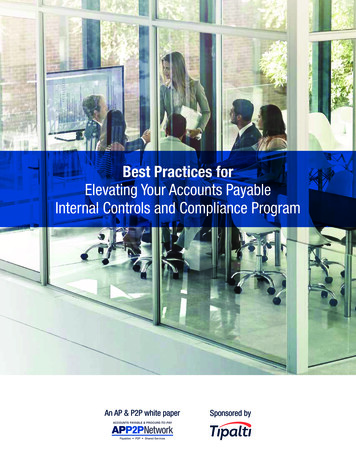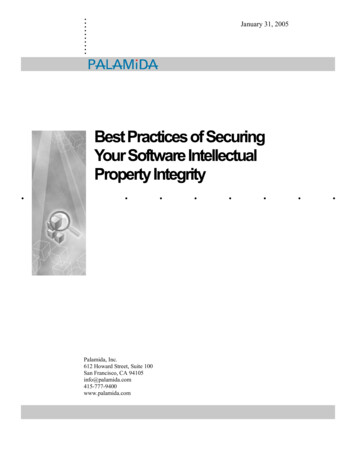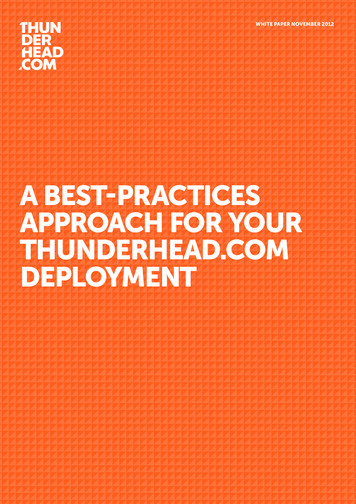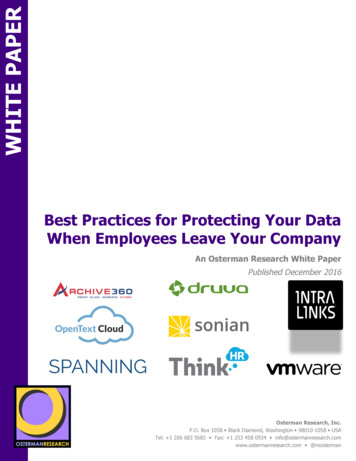
Transcription
WHITE PAPERBest Practices for Protecting Your DataWhen Employees Leave Your CompanyONAn Osterman Research White PaperPublished December 2016sponsoredbysponsoredbyred bysponsored byd bySPONred bysponsored bysponsored bysponsored bysponsored byOsterman Research, Inc.P.O. Box 1058 Black Diamond, Washington 98010-1058 USATel: 1 206 683 5683 Fax: 1 253 458 0934 info@ostermanresearch.comwww.ostermanresearch.com @mosterman
Best Practices for ProtectingYour Data When EmployeesLeave Your CompanyEXECUTIVE SUMMARYWhen employees leave a company, whether voluntarily or involuntarily, it is quitecommon for them to take sensitive and confidential data with them. For example: A survey published by Biscom in late 2015 found that 87 percent of employeeswho leave a job take with them data that they created in that job, and 28percent take data that others had created. Among the majority who tookcompany data with them, 88 percent took corporate presentations and/orstrategy documents, 31 percent took customer lists, and 25 percent tookintellectual propertyi. A survey of 1,000 employees in the United States and Europe found that one infive had uploaded sensitive and confidential corporate data to an external cloudservice specifically for the purpose of sharing it with othersii. As just one example of data theft by departing employees, in September 2016the US Office of the Comptroller of the Currency (OCC) detected the November2015 theft of more than 10,000 records by a retiring employee that may haveexposed personal information about OCC employeesiii.KEY TAKEAWAYSHere are some of the important takeaways presented in this paper: Employee turnover is a fact of life: the typical organization in the United States,for example, can expect that 24 percent of its employees will leave each year,although some companies in the Fortune 500 experience much higher turnoveriv. Employees who leave their employers, regardless of the reason for theirdeparture, often take with them sensitive and confidential information, such asintellectual property or trade secrets, that belongs solely to their employer. The theft of this information can damage a company in a variety of ways,including putting them at risk of a regulatory violation, forcing them to take legalaction against former employees, harming their competitive position, andnegatively impacting their revenue. To reduce the risk of employees taking information with them when they leave,employers should establish detailed and thorough policies and proceduresfocused on ensuring visibility into employee practices, limiting employee accessto data, requiring encryption of sensitive data, managing devices properly,ensuring that data is backed up and archived properly, and ensuring that IT hasaccess to all corporate data to which it should have access (some confidentialdata, such as HR data, should not be available to IT in all cases. To support these policies and procedures, organizations should evaluate anddeploy various technology solutions. Technologies that should be considered, butnot all of which need to be deployed, include content archiving, file sharing andcollaboration, encryption, mobile device management, employee activitymonitoring, data loss prevention, logging and reporting, virtual desktops andother solutions that will minimize the possibility of employees misappropriatingcorporate data upon their departure.ABOUT THIS WHITE PAPERIn support of this white paper, Osterman Research conducted an in-depth survey of187 IT and/or HR decision makers and influencers in organizations of various sizes,primarily in North America. Some of the results of that survey are included in thiswhite paper, but the full survey results will be published in a separate survey report. 2016 Osterman Research, Inc.1
Best Practices for ProtectingYour Data When EmployeesLeave Your CompanyThis white paper and survey were sponsored by Archive360, Dell/EMC, Druva,Intralinks, OpenText, Sonian, ThinkHR and VMware. Information about each of thesesponsors is included at the end of this paper.EMPLOYEES LEAVE COMPANIESThe United States Bureau of Labor Statistics reports that, as of January 2016, themedian tenure of employment for US-based employees was 4.2 years, slightly shorterthan the 4.6 years reported in January 2014v. This means that the typicalorganization can expect an annual turnover of about 24 percent of its workforce eachyear. However, Millennials (those aged 18 to 34 years) change jobs about every twoyears, and so the problem of turnover is likely to become worse as Millennialsbecome a larger proportion of the workforce.Moreover, while most employees leave organizations voluntarily, there are hundredsof thousands of involuntarily terminations each year, primarily reductions in force. Forexample, in 2016 alone the US tech industry is expected to lay off more than 260,000employeesvi, and the US oil industry laid off more than 350,000 employeesvii, to namejust two of the many industries in which layoffs have been a relatively commonoccurrence.EMPLOYEES LEAVE COMPANIES WITH CORPORATE DATAWhile employee turnover and terminations bring with them a variety of corporatefinancial and logistical problems, they also create a wide range of data protection anddata management problems, as well. For example, respondents to the surveyconducted for this white paper reported a variety of problems related to employeeturnover and terminations, as shown in Figure 1. While there are generalizedproblems associated with loss of corporate expertise when employees leave, many ofthese problems are related to employees actually taking data with them when theydepart, or leaving it in locations that are unknown or inaccessible to corporate datamanagers.Figure 1Problems Related to Data ProtectionPercentage of Respondents Indicating Significant or Major ProblemsSource: Osterman Research, Inc. 2016 Osterman Research, Inc.2
Best Practices for ProtectingYour Data When EmployeesLeave Your CompanyMany employees leave their employers with a wide variety of data types that caninclude confidential or sensitive financial data, information on customers and keyaccounts, various types of intellectual property, price lists, marketing plans, salesdata, their database of contacts, company directories, competitive intelligence,product plans and other information that belongs to their employer.WHY DO THEY TAKE DATA WITH THEM?Employees who leave with corporate data when their employment has ended do sofor one (or more) of three reasons: They do so inadvertentlyIn an era of Bring Your Own (BYO) devices, cloud applications, cloud storage,mobile apps and other elements of “shadow IT”, departing employees can oftenleave with substantial amounts of corporate data and not even realize orremember that they still possess it. Moreover, because a large and growingproportion of employees work at least some of the time from home, if only afternormal work hours, they often maintain a rich source of corporate data on theirpersonal desktop and laptop computers, USB sticks, personally managed file syncand share tools like Dropbox, and in other locations. They don’t feel it’s wrongSome employees will knowingly leave with corporate data upon their terminationbecause they don’t feel it’s wrong to take it with them, or that it will not harmthe company. For example, an employee who has worked to foster key clientrelationships, created valuable intellectual property, or is leaving a financiallytroubled company that may soon be going out of business may feel justified intaking corporate data with them, often because they feel the data belongs tothem. The problem is exacerbated by corporate data protection policies that arenot enforced or by the lack of security or monitoring technologies designed toprotect against data exfiltration. They do so with malicious intentSome employees will take corporate data with them upon their departure withmalicious intent. Some employees might be angry with company managementbecause they were laid off or otherwise terminated involuntarily, they might havebeen passed over for a promotion, they may have a personal dispute with theirmanager, or they might want to gain an advantage in their new job by havingsensitive or confidential information from their former employer. Whileemployees who take and/or destroy data maliciously may represent only a smallproportion of total data loss in an organization, the damage they do can besignificant.SIGNS OF UNUSUAL EMPLOYEE BEHAVIORWhen employees are planning to steal corporate data or are in the process of doingso, there are often one or more signs to which management should be sensitive: Employees will copy information to the cloud, USB drives, personal devices,personal email accounts, personal file sync and share accounts, other cloudstorage systems and to other venues. While this is a common occurrence in theera of BYO and is often performed by employees who are simply doing their job,a spike in any of these activities might be a sign that an employee is about toleave and is exfiltrating data in advance of his or her departure. A significant number of documents deleted from an employee’s desktop or laptopcomputers, corporate file shares and other data repositories. Sudden spikes or drops in email activity. 2016 Osterman Research, Inc.3
Best Practices for ProtectingYour Data When EmployeesLeave Your Company Unusually timed employee access to corporate accounts or facilities, such as aCRM system or financial account that is accessed at odd hours or differently thanthe employee’s normal pattern of accessing this information. Emails or other communications sent or received between an employee andcompeting organizations.THE CONSEQUENCES OF EMPLOYEES LEAVINGWITHOUT APPROPRIATE PROCESSES IN PLACEData exfiltration on the part of departing employees can create a variety of problems,ranging from the simply annoying to those that could potentially put a company outof business. Compounding the problem is that more than one in five of theorganizations we surveyed for this white paper does not have a way of retrievingdata that was under the control of employees when those employees leave.LOSS OF INTELLECTUAL PROPERTYMost businesses have trade secrets, designs, patents, customer lists or otherconfidential information that constitute a valuable store of intellectual property uponwhich they depend to run their business. If this data is taken by a departingemployee, it can cause significant harm to a company’s finances, revenue prospectsor reputation, not to mention the sometimes-significant cost of engaging in litigation.Here are a few examples to consider: A former manager at the industrial division of Ferguson Enterprises, a plumbingwholesaler (with more than 39,000 employees operating in 25 countries andlisted on the London Stock Exchange), is alleged to have copied sensitiveinformation, including contact information for customers, onto a USB drive andvia his personal Dropbox account for the purpose of setting up a competingfacilityviii. A software development manager at BlueScope learned she was to beterminated and immediately began downloading a large number of BlueScope’strade secrets. The company believed the data to be so sensitive that it initiatedan emergency legal action in the Federal Court of Australia, as well as inSingapore, to prevent competitors from accessing the dataix. Atlantic Marine Construction Company initiated legal action against a former vicepresident of the company, alleging that he stole trade secrets from the companyafter his termination. The suit alleges that the former employee had installedGoogle Chrome Remote Desktop without authorization while he was employedby the company, and then accessed the company’s network at least 16 timesafter he left for the purpose of exfiltrating various types of confidentialinformationx. An employee of Leica Geosystems in Australia downloaded approximately190,000 files containing sensitive and confidential information the day before hesubmitted his resignation. On his last day with the company, he deleted roughly54,000 of those files, but downloaded an additional 190,000 files during a fivehour period. Leica sued the employee in the Australian federal courts, the resultof which was a fine of A 50,000 levied against the employeexi.LAWSUITS AND OTHER LITIGATIONLoss of intellectual property and other examples of data exfiltration by formeremployees can lead to lawsuits and other litigation, both on the part of employerswho are suing ex-employees, as well as countersuits from former employees. 2016 Osterman Research, Inc.4
Best Practices for ProtectingYour Data When EmployeesLeave Your CompanyLOSS OF REGULATED DATA OR DATA SUBJECT TO LEGALHOLDAn employee who exfiltrates or deletes data upon his or her termination can causeserious harm by placing his or her former employer out of compliance with aregulatory obligation by breaching the data, or preventing that company fromcomplying with its legal obligations, such as data that is subject to a litigation hold orcourt-ordered eDiscovery. This data might include Protected Health Information(PHI), Personally Identifiable Information (PII) or data that is subject to PCI DSSrequirements. The issue here is that misappropriated data can not only put anorganization at risk for it’s potential to be exposed, but also data that an employeemay have deleted or wiped from their device upon termination that is relevant to anon-going investigation or litigation, such as a patent suit.LOSS OF COMPETITIVE ADVANTAGEThe exfiltration of data by departing employees, particularly those in key positions insales, marketing, senior management, etc., can result in competitive harm. Forexample, an employee that misappropriates marketing plans, product plans, detailsabout customer purchases or purchasing plans, potential acquisitions or partnershipsand the like can create enormous harm to a company. The consequences mightinclude loss of sales continuity, loss of sales contacts, a reduction in the salespipeline, cancelled contracts and lost revenue.OTHER CONSEQUENCESThere can be a variety of other consequences that arise from employees exfiltratingdata from their employers. For example, an organization that does not properlymanage its data assets or monitor information flows may never fully understand whathas been taken by former employees. In the absence of appropriate data inventoryand management practices, employers might never be able to prove what employeeshave taken, when it was taken, and how it was exfiltrated. This can lead toinvestigations by regulators, government agencies and others who may subsequentlyinvestigate potential data breaches that the employer may never be able to addressfully.ESTABLISHING POLICIES AND PROCEDURESTo minimize or eliminate the potential for employees to exfiltrate data from theiremployer when they leave a company, there are a number of things that an employercan do to proactively address the problem: Ensure ongoing visibility of sensitive corporate dataIt is essential that organizations maintain complete, ongoing visibility of sensitivecorporate data across all of their endpoints, cloud applications and any otherrepositories where this data might be stored. An important best practice toaccomplish this is the deployment of a content archiving system that will enablethe capture, indexing and immutability of content based on corporate policy.Email archiving is the logical and best first place to start the process of contentarchiving, but other data types – such as files, social media content, textmessages, web pages and other content – should also be considered forarchiving, as well. Limit employee access to dataCompanies should establish policies to limit employee access to sensitive andconfidential data by role, function, need to know, etc., although they must begiven access to the content they need to get their jobs done. For example, onlyrarely would engineering employees need to access data in CRM systems, norwould salespeople have a need to access HR data. While IT needs to be incontrol of corporate data, it should not have unfettered access to all information,such as sensitive HR files on employees, compensation, structural changes, etc. 2016 Osterman Research, Inc.5
Best Practices for ProtectingYour Data When EmployeesLeave Your CompanyBy limiting employee access to sensitive or confidential information, the potentialimpact of employees exfiltrating data can be mitigated. The use of solutions thatwill allow users to gain access to the content they need, but not more than theyneed, is essential. Encrypt data in-transit, at-rest and in-useSensitive and confidential data should be encrypted both in-transit and while it isat rest, regardless of its location. While manual encryption should beimplemented so that employees can encrypt sensitive content in email, forexample, Osterman Research also recommends the use of policy-basedencryption that will automatically scan content based on policy and then encryptit appropriately. Encryption alone can prevent much of the data loss that occurswhen employees leave a company. Require appropriate authentication for sensitive contentSensitive and confidential information should be protected with goodauthentication to prevent its access by unauthorized parties. For example,relatively benign sensitive data might require just a username and password foraccess, while more sensitive or confidential information might require two-factorauthentication. Decision makers should also consider the use of risk-basedauthentication that will impose authentication commensurate with the sensitivityof the information being accessed, the location from which it is being accessed,the time of day it is being accessed, and other relevant parameters. In somecases, it may be appropriate to create policies that will alert, or require approvalfrom, a compliance officer when certain types of data are requested. Manage mobile devices and laptops properlyBecause of the significant amount of data stored on smartphones and laptops, itis vital that every mobile device can be remotely wiped so that former employeesno longer have access to the content stored on these devices. This is particularlychallenging in Bring Your Own Device (BYOD) environments, since corporatedata may be stored on personally owned devices and IT often will not have theability to remotely wipe these devices, allowing ex-employees to retain access tocorporate data. Ensure an effective backup policyEvery organization needs an effective backup policy to ensure that all corporatedata is backed up, preferably to a central or easily accessible location. However,this is becoming increasingly difficult because of the use of personally managedfile sync and share tools like Dropbox, as well as other cloud repositories. WhileIT has the ability to properly back up all of the systems to which it has access, asignificant proportion of corporate content, when stored in personally managedrepositories, is not under IT’s control.The research conducted for this white paper found that fewer than three in fiveorganizations has a backup and recovery solution to ensure that data can berecovered if an employee maliciously changes or deletes data prior to informingthe company of his or her departure. Insert clear confidentiality provisions in employment contractsEmployment contracts and agreements should include clear language about theprovisions for protecting sensitive and confidential data while employees areworking for a company, as well as when they leave. While these provisions maybe disputed by employees after they leave a company, or may be disregardedaltogether, employers at least have some basis on which to defend a position ifthey decide to pursue non-compliant ex-employees. Develop policies on proper use of platformsIt is essential that all organizations have acceptable use policies regarding theproper use of cor
Intralinks, OpenText, Sonian, ThinkHR and VMware. Information about each of these sponsors is included at the end of this paper. EMPLOYEES LEAVE COMPANIES The United States Bureau of Labor Statistics reports that, as of January 2016, the median tenure of employment for US-based employees was 4.2 years, slightly shorter
